I think I am beginning to understand a thing: there are certain lathe accessories that are strictly “build your own” because making them for sale would be difficult (given machine compatibility) and legally dangerous. You’re not going to make any money selling a low-margin piece of tooling because your first customer who doesn’t read the directions and winds up with a chunk of resin sticking out of their forehead, well, there goes your promising career as a toolsmith.
I’ve mentioned vacuum chucks before, so let me give you a small view into the process as it stands for me right now. The head-stock of a lathe is pretty simple, in principle: it’s a threaded mandrel you attach a face-plate or chuck to, and there’s a pulley, a motor, and bearings. That’s basically it. For reasons of “it doesn’t need to be solid” the mandrels are historically hollow steel, 1″ threaded 8 threads-per-inch. That way, any face-plate you want (or a chuck or whatever) can go on it. The tailstock, typically, has a morse taper that usually holds a pointy thing (the “center”) or a ball-bearing’d pointy thing (an “active center”) that holds the other end of the work-piece while it spins.

A morse taper is a very clever invention of machinists. Instead of having a shaft, what if you had a very slightly tapered shaft? Then, you could just put it in a very slightly tapered receptacle and give it a gentle tap with a mallet, and it’s going to stay there because of friction. But it’s easy to swap out and as long as everything you might want to install there has a standard taper, you can quick-swap things. In the collection above, the one on the right is threaded and has a collar you can mount a drill chuck on! It takes a second or less to swap a morse taper’d thing, so you can imagine easily putting anything on there that makes sense. For example, I often put a drill chuck with a great big forstner bit on it, and I can use my lathe as a very straight drill-way.
But here’s where it gets fun: there is a special kind of tailstock center, which is an “active” center (ball bearings) that has a short 1″ 8/tpi stud on the end. That way, you can have two chucks holding your work-piece: one is on the belt-driven mandrel in the head, the other spinning freely, but your work-piece is going nowhere as long as you remember to lock everything carefully.
Serious machinists learn how to make morse tapers in their sleep, because (until recently) most milling machines and other shop tools use some size morse taper or other. So if you have a metal lathe and know how to use it, you can cut a taper in a piece of tool steel and then manufacture whatever you want on the head, put it in your milling machine, and really fuck some shit up mill stuff. I’m almost 60 years old, and I sigh a bit wistfully as I write that, because a serious machinist I will never be: you have to start that as a teen-ager and by the time you are 60 you’re a serious machinist. There’s not enough runway for Marcus and that’s OK: it’s an endless learning curve and you jump on where you jump on.
All of that is prep, to say that if I were a serious machinist, I’d make my own face-plates. I have a metal lathe and I could do it, but it’d take hours and they’re $19 on ebay, made by a serious machinist in China. [And please let me not get started about American attitudes toward Chinese manufacturing, which are exactly the same as 19th-century British attitudes toward American manufacturing until WWI was over] So, to make my ball-holder cups, I obtained two face-plates and then epoxied together a stack of cut plywood discs, then screwed them to the faceplate and mounted the faceplate, turned it even, and started smoothing it down.

I love how serious machinists are, even when they are making something for a wood-worker. I went over the faceplate with a caliper and the measures between the two are accurate to 1/10,000 or so. You’ll notice the lovely chamfering between the plate and the socket – it was not necessary to do that, but that’s how machinists do things. The screw-holes are all counter-sunk so that the screws tend to locate themselves near the center of the hole; I am pretty sure that I could dis-mount my plywood and re-mount it and it’ll be pretty much in balance.

I don’t need anything in the tailstock, because my work-piece is my face-plate and it’s not going anywhere so long as I keep my chisels out of those titanium-coated high carbon steel screws that I used to hold the plywood on. That would get remarkably ugly. Always work carefully when you are near something that has metal in it; it could launch your chisel like the Spear of Longinus if it catches and the lathe is spinning fast.
Above, I have a chuck on a taper in the tailstock, with a forstner bit. My mission was to make a hole through the wood to the steel. I did that by measuring the thickness of the wood with a caliper and then cranking the tailstock out that much. Done! There was a tiny thin sheet of plywood at the end, later, which I pushed out with my thumb. (see, real machinists don’t work with materials you can just push around with your thumb, so their cut has to be 1/1000″ more precise than mine was. I was just happy I didn’t grind the forstner bit into the metal of the faceplate.

Then I made a curved surface in the face of the plywood, and sanded/polished the whole thing, and started sealing the wood with a couple coats of tru-oil.
Now, what’s going on here?

In principle, I have two things I can clamp a ball between. The curvature isn’t going to mate perfectly, of course, but I can put some double-stick tape in there and it’ll be good enough. Then, I can turn things into a round shape by simply clamping and re-clamping my work-piece and making it round from a couple of angles.
But, wait, there’s more! You can see that I made the hole clear through to the metal faceplate. So, what you do (I almost have this all rigged, I just need some hose connectors and patience) is run a threaded pipe through the mandrel of your headstock, with a nut on one end that locks against the inside of the hole (with a rubber gasket) – on the other end, you have another nut, and what’s called a “mechanical coupler” – a mechanical coupler is a doo-dad that provides a leak-proof rotating connection – think: how does the propeller of a boat get out through the hull and still be able to turn? They’re one of the wonders of the world created by serious machinists: a couple of plates that are in such close contact that air won’t slither between them, but that can still turn against eachother; I believe that is accomplished with a thin film of oil to keep the air out. Magic! Anyhow, when you have the coupler on the other end of the mandrel, the mandrel can turn but the other end of the coupler doesn’t have to. To that, you attach a hose and attach that to a vacuum pump. Then you put your object up against the cupped end of the holder, engage the vacuum, and it sticks there like it’s glued there. Until you disengage the vacuum and it falls off. So, I’m building a pair of ball cups where one will provide drive (because it’s on the mandrel) and grip (because the mandrel has a strong vacuum through it).
That’s a typical vacuum chuck. Because I hate the idea of being working on the lathe, and having a power blip, which launches a ball of resin at my face spinning 2,000rpm, I’m going to spend $150 for a uninterruptable power supply that I can use to condition the power to the vacuum pump. The UPS will have to keep the vaccum pump running for the (approximate) 10 seconds it takes for the lathe to spin down. I am not aware of other vacuum chucks that incorporate a UPS but it sure seems like relatively inexpensive insurance.
Maybe this week I’ll be able to fire it all up. I just need the brass fittings and some quick disconnect fittings for the vacuum pump, and a larger outlet box to power the UPS, and stuff like that. It’s very close to complete.
Before I start using them, I am going to make a silicone mold of the plywood part (which means taking it off the faceplate) so I can cast new cups out of polyurethane rubber, that will grip balls a bit better since they’ll have slight “give” to them. I’m going to use some shore-90 rubber and I’ll cut some discs out of fiberglass window screen to put in the molds to make them more dimensionally stable at the base.
Then I’ll be ready to turn some resin eggs and bowls! I may as well make it as safe and easy on myself as I can.

Unrelated, I have been doing a bunch of prep-work for some turnings. That’s ungratifying and not visually interesting work. It’s also kind of stressful, because it entails gambling largeish amounts of resin, which is not inexpensive. As the size of your work-piece goes up, the cost in resin goes up (dramatically) and the likelihood there will be flaws and bubbles goes up, too.
Meet: the ant log

I believe it is ash wood(?) I’m not sure. But, when I got it, it was home to a hive of ants. I found that out when the bandsaw was halfway through and the upset ants came boiling out to discuss it with me. I left it outside for a few days so they could decamp peacefully, then trimmed it up and soaked it in light resin, cooked it, and dried it. Now, the wood should be pretty strong and have less air in it. My plan is to put that in a bucket (it fits perfectly) and fill it with clear resin. Then, if I can turn it into a bowl, it’ll look like ant farm, maybe. Or maybe it’ll look like bowl. We’ll see.
Then, there is Son of Broken Oak:
 This time I individually pressure-soaked each piece in resin before I glued it to the plywood base. All I need to do now is finish taping up the polypropylene sheet collar around it, and pour in about a gallon of resin. Woof. That’s about $100 worth of resin right there so I do not want this to screw up. Nor do I want it to leak. That’s why I keep picking it up, looking at it, and saying, “maybe later.”
This time I individually pressure-soaked each piece in resin before I glued it to the plywood base. All I need to do now is finish taping up the polypropylene sheet collar around it, and pour in about a gallon of resin. Woof. That’s about $100 worth of resin right there so I do not want this to screw up. Nor do I want it to leak. That’s why I keep picking it up, looking at it, and saying, “maybe later.”
By the way: isn’t plywood surprisingly lovely? Eventually I’ll stack some up and make a bowl.

Here’s a thing I don’t understand – free blind spot that otherwise careful people have with the spelling of “vacuum”. As you might imagine, in my line of work (chartered chemical engineer) I see it a lot. Its just odd. I think the mind just prefers a double consonant and rebels against a double vowel that’s not an o or an e.
@sonofrojblake: I notice I have it both correct and incorrect. I guess I was hedging my bets.
ooh- that ant log sounds like a promising project.
I would have thought that a vacuum tank or reservoir would have been easier. Old propane cylinders make excellent vacuum tanks.
That ant log looks to be amazing.
Sounds as if you have done a lot of prep work for some potentialy lovely things.
So did Luer get the idea from Morse or the other way round? :)
The ant log sounds interesting. Insect tunnels are really cool patterns, i did a bowl where i managed to keep some on the outside and it makes a nice texture.
Depending on where they are i wonder if you could hide some lights in it?
The polyurethane are a great idea (i don’t suppose you feel like casting up another two?)
The ant wood is going to be cool.
I would like to offer a few possible word of caution though.
The first thing is that AC motors are nasty loads for UPSs. They can have large inrush currents, and because they are an inductive load they have large apparent power. Say your motor actually has a 250 watt power rating so you might think that 250VA is enough in your UPS. But, because it is an inductive (aka reactive) load, the current draw and the voltage applied are out of phase with each other. This means that the instantaneous product of the two can exceed that 250VA. These guys have a better explanation of the difference, since they can have tables and equations. You can also just google “VA vs Watts” for more.
On my second point, you may have already thought of this; but, I think $150 is probably far less than the type of UPS you need costs. A normal, consumer grade, standby / line interactive UPS costs in that range and those do not really “condition” power. If line voltage rises or falls without crossing the “cut over threshold,” they don’t help you. They basically act like a really good surge protector with fast, but not instant, switch to battery backup. Further unless you buy at the high end of the consumer grade UPS their output is not a smooth sinusoid but is instead a stepped approximation to that. Most motors will very much not like that stepped approximation (see what APC has to say about motors and sinusoids)
As I see it this means there are three issues with a normal consumer grade UPS.
1) If power “blips” there will be a very brief blip that can reach the motor. That might be enough to let something come loose and then you have face full of wood and resin issues again.
2) If your power does not go out but the voltage rises or falls the vacuum pump may react badly to that as well and
3) The stepped sinusoid approximation when it does cut over to backup may cause the pump to have problems even if the blip before the cut over does not.
I am pretty sure you need an online double conversion UPS. Unfortunately, they do cost significantly more than $150, but there are a number of benefits to them.
1) Almost of all them are true sinusoid right out of the box (check the features to be sure)
2) Since they constant feed the load from battery (and constantly feed the battery from mains) no blip will make it to your motor if power does go out.
3) They truly condition power since the line power never actually goes directly to the load, helping prevent issues with non-outage type blips.
4) Most will have more than enough VA out of the box to handle big AC motors.
I have no horses in this race. I have only used online systems for scientific experiments that I have participated in (and there I did not spec and procure it). My home computer just gets a standby UPS, since switched mode power supplies are rugged little bastards. It is entirely possible that for your purposes a regular UPS would be enough, I have done no tests and the double conversion UPSs are significantly more expensive than the regular ones. But I wanted to mention these things in the off chance that you didn’t know about them / hadn’t factored them in to your safety margin.
Anyways, sorry for the wall of text. The upcoming projects look awesome, and make me kinda want to get a lathe.
dangerousbeans@#7:
The polyurethane are a great idea (i don’t suppose you feel like casting up another two?)
Not a problem. Do you have a place where you can get 2 cheap face-plates? I can cast the poly without drilling holes for screws.
So, after all the talk about not hitting the screws in the plywood, guess who snagged the back of his index finger on the tip of one of those screws, while the lathe was going about 1500rpm? Yeah. It wasn’t bad; it just shredded right through but it did two rotations before I was able to get my hand out of there. Surface damage but that ended my day.
Lofty@#4:
I would have thought that a vacuum tank or reservoir would have been easier. Old propane cylinders make excellent vacuum tanks.
Yeah, if it was all airtight. But I’m not sure if it really is, and I don’t want to have to bother. I can just have the pump keep drawing on it. It’s the kind of pump that isn’t damaged by continually pulling. I think.
Marcus @#10: YIKES on the fingers… bet you will remember that for some time to come… I hope you heal fast.
Those projects look awesome. Son of Broken Oak seems like a really cool one. The ant log is great too. I just love the idea of adding the resin to the wood; just seems brilliant to me, particularly since the range of color in resin is remarkable.
Marcus
Are you up-to-date on your tetanus vaccination?
Ouch, your poor finger
But I’m really looking forward to what you’ll do with your projects. Resin seems to be much more expensive in the USA than here, because for me a gallon would be about half that price.
BTW I have given in and got myself a cheap little lathe. Of course it’s still in its original box, because there have been ad still are like 25 things that take priority, but I’m really looking forward to trying things out. I so want to make resin rings. I like the idea of turning it into a horizontal drill stand, because i don’t have a drill stand (yet).
Also, I know what you mean by “machinists” and “accuracy”. My dad was a machinist by trade and while I generally like working with him, I also don’t know how much wood I had to file off because the idea of cutting away half a mm of material that could have been left standing abhors him.
Question: How frequent are power outs in the USA? Because here they are mostly a “lightning hit something badly, sorry” occurrences and when that happens you aren’t working on something anyway.
tetanus vaciination?
astringer @15
https://en.wikipedia.org/wiki/Tetanus_vaccine
fusilier
James 2:24
@Marcus, you should really use a vacuum gauge to see what the minimum holding value is and how much more the pump draws down in use. A reservoir that can keep a satisfactory vacuum as your machine spools down shouldn’t be more than a few bucks from your scrap dealer. Waaay cheaper than a hunky-sized UPS in any case.
On the other hand it may be possible to buy a DC electric vacuum pump for a diesel vehicle and run it off a truck battery and charger under the bench.
Yes, everyone – vaccines are up to date.
I live on a farm and am constantly in contact with sharp, rusty, metal.
I know my freedom to remain unvaccinated would be important to some people, but it’s not to me!
Lofty@#17:
@Marcus, you should really use a vacuum gauge to see what the minimum holding value is and how much more the pump draws down in use. A reservoir that can keep a satisfactory vacuum as your machine spools down shouldn’t be more than a few bucks from your scrap dealer. Waaay cheaper than a hunky-sized UPS in any case.
Yeah, I was thinking that. I actually already have a pressure tank that I could use as a vacuum buffer. Aside from that, a bit of testing with a lightweight object ought to tell me what I need to know.
James@#8:
You’ve certainly given me a lot to think about. I don’t think I’d thought things through well enough with the UPS idea. For one thing (as Lofy says@#17) it might take a while for the pressure to equalize enough for the work-piece to come loose.
I should mention that this would be one of my layers of defense. The main one is “never stand in line with the work-piece” and the second is that I always wear a face shield that is designed to spread impact. But, if I can add another layer of safety for a lowish price, I’d be crazy not to. I think I should build it and experiment with how long it takes for the pressure to equalize.
Gilliel@#14:
BTW I have given in and got myself a cheap little lathe. Of course it’s still in its original box, because there have been ad still are like 25 things that take priority, but I’m really looking forward to trying things out. I so want to make resin rings. I like the idea of turning it into a horizontal drill stand, because i don’t have a drill stand (yet).
Hurrah! The world needs more lathes!
Question: How frequent are power outs in the USA
Out here, there are a lot – relatively. The US power grid is mostly above ground, unlike in 1st world nations, because we started it early and regulated it late. Now, there are right-of-way issues: Amerikkkans won’t stand for having communist socialists digging power lines through their freedoms!
Killing power to the lathe and vacuum pump while running as a test sounds entertaining, when done from a safe distance :P
I can track down a couple of face plates easily. once i work out what spec my lathe is
I hope the finger heals quickly
dangerousbeans@#21:
I can track down a couple of face plates easily. once i work out what spec my lathe is
Usually it’s 1″ with 8 thread per inch. Some are 3/4″. It’ll be in a spec sheet or you can just lock the mandrel, screw off the faceplate, and have a look at it.
The finger’s not too bad – it’s 2 1/4″ deep cuts (that is: quantity two, depth 1/4″) about 1/2″ long and it’s in a part of my finger I’ve already messed up several times. No biggie.
I poured the silicone for the dome-things and I’ll make my set next week.
While I was in the Army back in the mid 70’s I was stationed in South Korea. It was there that I tangled with a winch on the front of a 5/4 ton truck and was given the nickname ‘Fingers’. Do not be like me. I have learned to get along with nine fingers, but really, take care of those things willya? By the way Marcus, would you be interested in a copy of Machinerys Handbook 23rd Edition? It served me well as a machinist for a long time but its been sitting on my shelf gathering dust. Im more than willing to donate it to your shop. Just a thought.
The cup mold is complete and looks good!
As soon as I get some fiberglass screening (hardware store->bug screen) and my liquid rubber arrives, I can make a few sets of these. Well, one a day, allowing for the cure-time for the rubber. Doing casting is a process that requires a certain patience and discipline.
StonedRanger@#24:
Do not be like me. I have learned to get along with nine fingers, but really, take care of those things willya?
Yeah, this is me being careful, actually. Sometimes things happen.
I’m just glad that I follow the sensible advice of others and was not wearing gloves! That was a big reality check for me.
The scars won’t even be visible because that part of my finger is already churned up from the time I ran a 1/8″ drill bit from my fingernail up to the knuckle with the drill spinning. It did not mate up prettily but I chalk it up to “normal wear and tear.”
If you want to send me the book, I would love it. Email me (mjr@ranum.com) or you can research my address from the web. ;) I’d be happy to reimburse your shipping, too.
Fascinating and well-explained. I’m looking forward to seeing the results of both the ‘Ant Log’ and ‘Son of Broken Oak,’ but mostly I want to see your new line of round things. Will there be crystal balls? Snow globes? Galaxies?
OP: …”a serious machinist I will never be: you have to start that as a teen-ager and by the time you are 60 you’re a serious machinist.”
Perhaps not so impossible as you might think. What little machine tool craft I was abcle to absorb was imparted by a man who trained to be a medical doctor, went through medical school, and had a practice for ten years before he realized his childhood dream of being a machinist was what he would be happy doing. He said he found humans, and their whining and non-specific complaints, to be annoying. “When a machine complains it always has a good reason.”
Being a frugal guy, and lucky with investments, he had some financial resources. He asked around to find out what the best school and apprenticeships were for machinists. Applied and was off to Michigan for an intensive live-in training program and an apprenticeship at 40. He followed up with years as a machinist producing one-off parts for prototype development and research at Ford and went on to work for NASA. I met him when he was semi-retired and was teaching part-time at a technical school. He was a hell of a machinist. He also maintained his MD.
One of the fist assignments in his class was to draw plans for a cube and then figure out how to convert what you drew into said cube from mild steel round-stock using nothing but chisel, hammer and a file. One kid figured if he got hurt he could avoid the protracted labor. We all had been warned to grind down any mushrooming of the chisel-head because chips can spall off a mushroomed head with enough force to embed deeply into the hand gripping the chisel. He ignored the danger and sure-enough he ended up with a nice chunk of steel in his paw. He went to Doc and announced that he needed to go to a doctor. Doc barely blinked he calmly walked to the file cabinet and extracted a classic black doctor’s bag. As the guy sputtered he washed it all up, probed for the chip and dug it out. Inside of ten minutes he had the wound bandaged and told him to get back to work. He even got a tetanus shot.
Any minor wounds and injuries got treated on-site. I suspect that you couldn’t work that way today but in the early 70s nobody seemed to mind.
The point is that it isn’t too late to follow your dreams. If the reaper takes you before you get there at least you were moving toward the goal.
Besides, people live longer now. Back in the 60s it was a running joke that middle managers vapor-locked in their 50s because … well … lots of them did. My father is 92 and was active until couple of years ago. Sixty is the new 40.